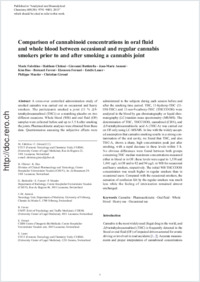Comparison of cannabinoid concentrations in oral fluid and whole blood between occasional and regular cannabis smokers prior to and after smoking a cannabis joint
- Fabritius, Marie UTCF Forensic Toxicology and Chemistry Unit , CURML University Center of Legal Medicine , Lausanne, Switzerland
- Chtioui, Haithem Division of Clinical Pharmacology and Toxicology, Centre Hospitalier Universitaire Vaudois CHUV , Lausanne, Switzerland
- Battistella, Giovanni Department of Radiology, Centre Hospitalier Universitaire Vaudois CHUV, Lausanne, Switzerland
- Annoni, Jean-Marie Neurology Unit, Department of Medicine, University of Fribourg, Switzerland
- Dao, Kim Division of Clinical Pharmacology and Toxicology, Centre Hospitalier Universitaire Vaudois CHUV , Lausanne, Switzerland
- Favrat, Bernard UMPT Unit of Psychology and Traffic Medicine , CURML University Center of Legal Medicine, Lausanne, Switzerland
- Fornari, Eleonora Department of Radiology, Centre Hospitalier Universitaire Vaudois CHUV, Lausanne, Switzerland - CIBM Centre d Imagerie BioMédicale, Centre Hospitalier Universitaire Vaudois, Lausanne, Switzerland
- Lauer, Estelle UTCF Forensic Toxicology and Chemistry Unit , CURML University Center of Legal Medicine, Geneva, Switzerland
- Maeder, Philippe Department of Radiology, Centre Hospitalier Universitaire Vaudois CHUV, Lausanne, Switzerland
- Giroud, Christian UTCF Forensic Toxicology and Chemistry Unit , CURML University Center of Legal Medicine , Lausanne, Switzerland
-
01.12.2013
Published in:
- Analytical and Bioanalytical Chemistry. - 2013, vol. 405, no. 30, p. 9791–9803
English
A cross-over controlled administration study of smoked cannabis was carried out on occasional and heavy smokers. The participants smoked a joint (11 % Δ9-tetrahydrocannabinol (THC)) or a matching placebo on two different occasions. Whole blood (WB) and oral fluid (OF) samples were collected before and up to 3.5 h after smoking the joints. Pharmacokinetic analyses were obtained from these data. Questionnaires assessing the subjective effects were administered to the subjects during each session before and after the smoking time period. THC, 11-hydroxy-THC (11-OH-THC) and 11-nor-9-carboxy-THC (THCCOOH) were analyzed in the blood by gas chromatography or liquid chromatography (LC)-tandem mass spectrometry (MS/MS). The determination of THC, THCCOOH, cannabinol (CBN), and Δ9-tetrahydrocannabinolic acid A (THC-A) was carried out on OF only using LC-MS/MS. In line with the widely accepted assumption that cannabis smoking results in a strong contamination of the oral cavity, we found that THC, and also THC-A, shows a sharp, high concentration peak just after smoking, with a rapid decrease in these levels within 3 h. No obvious differences were found between both groups concerning THC median maximum concentrations measured either in blood or in OF; these levels were equal to 1,338 and 1,041 μg/L in OF and to 82 and 94 μg/L in WB for occasional and heavy smokers, respectively. The initial WB THCCOOH concentration was much higher in regular smokers than in occasional users. Compared with the occasional smokers, the sensation of confusion felt by the regular smokers was much less while the feeling of intoxication remained almost unchanged.
- Faculty
- Faculté des sciences et de médecine
- Department
- Médecine 3ème année
- Language
-
- English
- Classification
- Biological sciences
- License
-
License undefined
- Identifiers
-
- RERO DOC 209400
- DOI 10.1007/s00216-013-7412-1
- Persistent URL
- https://folia.unifr.ch/unifr/documents/303558
Statistics
Document views: 148
File downloads:
- pdf: 397
